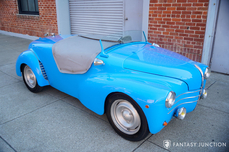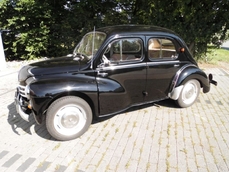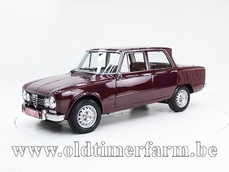Renault 4CV '56 1956
General description :
‘Ferlec’-powered edition with electromagnetic clutch 2CV’s concurrent Defined Renault’s history The Renault 4CV, also known as the 'butter pat' due to its original only-yellow paint, was introduced in 1946 at the Paris Auto Show. As peace gradually started spreading across Europe, Renault, much like Volkswagen, decided to create a car for their people, the French, who had been deeply scarred by a furious five-year war. In secret, without official agreeance, three Renault colleagues decided to bring this idea to life. They did so without much regret, as over the years, the 4CV evolved into an essential icon for Renault. Louis Renault, the founding father of Renault, saw cars and automobiles as luxury items that the average Joe could not afford. Despite having seen the concept of the Volkswagen Beetle in 1939, he had no intention of manufacturing a budget-friendly car. Moreover, the German occupation ruling the Renault factories made the future look bleak. Though, secretly, three Renault executives conceived the unexpected and unwanted. Their view stood in stark contrast to Louis Renault's, as they believed the people needed an affordable, small car. They began designing the 4CV as early as 1940, but it wouldn't be available until after the war, following the arrest and death of Louis Renault and the subsequent appointment of a new CEO at Renault, who would grant approval for a car for the people – a car with four doors instead of the original two-door prototypes. It wasn't until 1947, after factory rebuilding and sufficient gathering of production components, that the production of this mass-produced car began. Initially, only fifteen 4CV’s were built per day, but production quickly accelerated to 375 per day. The 4CV was a success, even in America, where in 1951, they ordered a whopping 170,000 of this people's car equipped with a 747 cc straight-four engine, originally delivering 17 horsepower, which was gradually increased to 21 horsepower over the years. Production continued until 1961, running in parallel with the production of the Citroën 2CV, which was also the direct rival to the 4CV due to the interminable waiting times at Citroën. Early on, the 4CV managed to influence legislation in its favour; its headlights were mounted lower than legally specified, prompting a change in French law. Furthermore, it became the first French-of which a million were sold, eventually reaching 1.1 million. Today, it stands among the ranks of classic cars with a high degree of compliment, alongside the Mini, Fiat 500, Beetle, and 2CV. Technical information: Body work Length (cm): 364 (143 inch) Width (cm): 143 (56 inch) Height (cm): 147 (58 inch) Wheelbase (cm): 210 (83 inch) Weight (kg): 560 (1235 lbs) Mechanics Engine: straight-four 747 cc rear-engine Valve gear: 8 Fuel system: 1 Solex carburettor Gear box: 4-speed manual (and automatic clutch by Ferlec) Transmission: RWD Left-steered power: 21 hp (16 kW) at 4100 t/m torque: 45 Nm at 2000 t/m Top speed: 100 km/h (62 mph)
1956 Renault 4CV '56 is listed for sale on ClassicDigest in Aalter by Oldtimerfarm for €12500.
Car Facts
Car type : Car Make : Renault Model : 4CV Model Version : '56 Engine size : 0.0 Model Year : 1956 Location : Aalter Vehicle Registration : Undefined
12500 €
People who viewed this Renault 4CV also viewed similar Renault listed at ClassicDigest
Other cars listed for sale by this dealer
About Renault
Ah, Renault, a name that's as French as a croissant and as ingrained in automotive history as a baguette in a Parisian café. Let's take a leisurely drive through the annals of this storied manufacturer, shall we?Our story begins in the late 19th century when the Renault brothers, Louis, Marcel, and Fernand, decided to put their inventive minds to work. In 1898, they introduced their very first car, the Renault Voiturette. It was a petite, rear-engined contraption that looked like something Jules Verne might have designed. This pint-sized pioneer laid the foundation for Renault's automotive legacy.
Now, if we're talking about influential Renault models, we mustn't overlook the Renault 4. Launched in 1961, it was the French answer to the Volkswagen Beetle. The Renault 4 was practical, versatile, and designed to handle the rough and tumble of rural France. It was as much at home in the city as it was on a farm, a true embodiment of French pragmatism.
But let's not forget the Renault 5, or "Le Supercinq" as it was known in France. Introduced in the mid-'70s, this little hatchback was a design sensation. Its quirky, angular lines and cheeky personality made it an instant hit. It was economical, fun to drive, and became an icon of French urban life.
Then came the Renault Espace in 1984. It was one of the pioneers of the MPV (multi-purpose vehicle) segment. The Espace was designed for families who wanted the practicality of a van without sacrificing the comfort of a car. It was the beginning of a new era in family transport.
And let's not forget the Renault Twingo, introduced in 1992. It was a small city car that broke the mold with its innovative design and rear-engine layout. The Twingo was proof that small cars could be stylish and practical, and it was a hit with urban dwellers across Europe.
Now, if you want to talk about a true game-changer, it's the Renault Clio. First introduced in 1990, the Clio became a European favorite. It combined style, performance, and affordability in a way that few cars could match. It's the kind of car that's as comfortable on the Champs-Élysées as it is navigating the narrow streets of a French village.
But, of course, we can't forget the Renault Megane. It's been a stalwart of the compact car segment since its debut in 1995. With its distinctive rear-end design and a range of engines to suit every taste, the Megane has remained a strong contender in a competitive market.
So there you have it, a leisurely tour through the history of Renault, a company that has always managed to infuse a touch of French flair into the automotive world. Renault has given us cars that are as diverse as the French countryside itself, from practical workhorses to stylish city slickers. It's a brand that's as much a part of France's cultural tapestry as a bottle of Bordeaux or a game of pétanque. Vive la Renault!

























